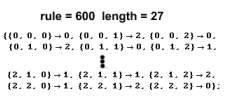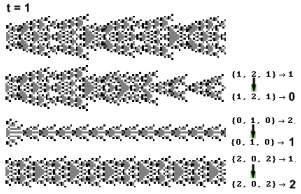 |
Context of a process-1
All processes of our body interact. We may distinguish between close and remote interactions. Somatic, or age injuries, are of the first kind. CA rule stands for the effect of remote processes. Hitherto CA rule was kept constant so that remote processes (CA) did not interact with the observed CA. The context of these experiments was narrow. A previous experiment described how the context may be broadened by letting one CA control the rule of another one . In the present experiment CA rule is controlled by the observer.
 |
The outcome varied. Some CA expanded indefinitely, other
became chaotic and the rest died. The second CA depicted below went through a transient phase and then started
oscillating. This outcome is a (viable)
solution .
 |
Next, the
outcome of each transformation at a time
was set to one, and the
experiment was repeated 27 times. In the last run the outcome of each transformation
at a time was set to two
Rule injury changes
the rule, and is meaningful only if inducing a solution. The set of
totalistic rules is vast. Let's call it A. The set of totalistic
solutions is much smaller, as this experiment illustrates. Let's call it
B < A. We might
enumerate totalistic solutions by examining all totalistic rules. Let's
call this set C. C
contains many solutions which are not relevant to the CA[rule=600]
above. In order to be relevant, a solution has originate in one of
the 46 states through which
Setup
nca=1 zygote -> effect[no 1000]; go109]; restoreparams;
putinstep [ If[j > mm =19, rul1[[21,2]] = 2; rul[[1]] = rul1]; go[100];
solutions: {a. color, rule-position, time} a017mm, a221mm.
Next page